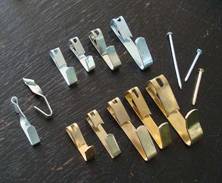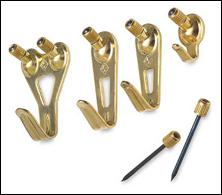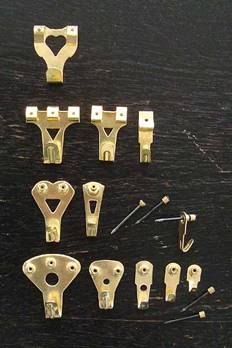 Photo 1
Photo 1
Standard wall hangers made of zinc and brass.
The selection of a wall hook—or hanger—is just as important as the wire and frame hardware. When selecting wire it was stated in the June column "Which Wire" that the break strength of the selected wire should be three times that of the weight of the framed painting. When selecting wall hangers that is even higher with the support weight needing to be four times that of the art. So a 10# hanger will only actually support a 2½# painting. Two 10# hangers increase the weight tolerance to 5#. In turn it takes two 50# hangers, equaling 100# total weight tolerance, for a 25# painting.
Picture wire should always be hung onto two horizontal wall hangers—even for a small 1# piece—at approximately ⅓ and ⅔ intervals across the width of the frame, box or canvas. This will both balance the frame to better maintain the alignment and prevent shifting from closing doors, and will hold the frame flatter to the wall with less forward tilt. Keep in mind the wall hanger style selected plays a significant part in the hanging of framed art.
Standard Hook Style
Standard zinc and brass picture hangers (photo 1) are strong, economical, and dependable while hung, but the nails are thicker and able to move in the hanger not maintaining a common angle during installation. For maximum strength the nail should be held to 30 degrees penetration and the design of most standard hangers has enlarged slots that allow for slop in the nail placement. Unlike the Floreat these hangers may be easily pulled from the wall when a painting is removed which can damage and enlarge the hold in the wall and/or allow the hook to fall out.
 Photo 1
Photo 1
Standard wall hangers made of zinc and brass.
Notice the extreme variance in the nail slant of all these standard hooks in photo 2. The elongated nail slots allow inconsistency when installing these type of hooks. There is a huge nail angle variation so installation could be far less secure if installed at a flatter nail angle, in fact if too flat the hook could pull from the wall.
 Photo 2
Photo 2
Note the flexibility of the insertion angle of the nail. Even the floreat replica far left is not at 30 degrees.
Floreat Style
Ziabicki Floreat Hangers are the original German made picture hooks which remain the preferred brand of hangers among professionals in the custom framing industry (photo 3). They have thin tempered steel nails and solid brass knurled heads designed to be thin, strong and have nail guides that control entry of the nail into the wall at an optimum 30 degree angle. There is a small Z trademark stamped above the opening on all authentic Ziabicki product. These have often been imitated but never truly duplicated by Moore, OOK, and as many private label brands (photo 4). They are made in assorted sizes to hold 10, 20, 30, 50, 75 and 100 pounds. Ziabicki Floreat Hangers are available online or through your local professional framer.
 Photo 3
Photo 3
Ziabicki Floreat hangers are all stamped with their trademark. Only 50#, 30#, 20# and 10# shown.
 Photo 4
Photo 4
Floreat-style hangers: unknown copy (top); Moore version of Ziabicki Le Crochet; OOK 50# and 30#; private label versions (bottom).
The most commonly seen floreat replica is the OOK Professional Picture Hanger which claims to distribute the weight of the picture evenly to support heavy paintings while not damaging walls. Their nail inserts into wall at a similar angle as the Floreat, are secure, reusable, and work well for plaster or sheetrock. They are less expensive and widely available at home improvement, hardware, craft and grocery stores.
Wall hangers such as these are definitely not the only hardware available, though most common. Cleats and bar systems are another option for hanging heavy art, particularly boxes and canvases which shall be covered in a future article.
END
Copyright © 2011 Chris A Paschke
For more articles on mounting basics look under the mounting section in Articles by Subject.
There is a special section in the library for all past IEA Framing Matters articles from Wax-On!
Additional information on all types of mounting is found in:
The Mounting and Laminating Handbook, Second Edition, 2002,
The Mounting And Laminating Handbook, Third Edition, 2008 and
Creative Mounting, Wrapping, And Laminating, 2000 will teach you everything you need to know about getting the most from your dry mount equipment and materials as an innovative frame designer.
All books are available from Designs Ink Publishing through this website.
Chris A Paschke, CPF GCF
Designs Ink
Designs Ink Publishing
785 Tucker Road, Suite G-183
Tehachapi, CA 93561
P 661-821-2188
chris@designsinkart.com